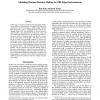54 search results - page 4 / 11 » ce 2006 |
AAAI
2006
13 years 8 months ago
2006
In this paper we propose a model for human learning and decision making in environments of repeated Cliff-Edge (CE) interactions. In CE environments, which include common daily in...
JSYML
2002
13 years 7 months ago
2002
A computably enumerable (c.e.) degree is a maximal contiguous degree if it is contiguous and no c.e. degree strictly above it is contiguous. We show that there are infinitely many ...
HICSS
2006
IEEE
14 years 1 months ago
2006
IEEE
The focus of this paper is to introduce a comprehensive model for assessing and improving the maturity of Collaboration Engineering (CE) processes. The model is targeted at introd...
CORR
2006
Springer
13 years 7 months ago
2006
Springer
The cross-entropy method (CE) developed by R. Rubinstein is an elegant practical principle for simulating rare events. The method approximates the probability of the rare event by...
JC
2000
13 years 7 months ago
2000
The Turing degree of a real number x is defined as the Turing degree of its binary expansion. This definition is quite natural and robust. In this paper we discuss some basic degr...


